
95% of researchers rate our articles as excellent or good
Learn more about the work of our research integrity team to safeguard the quality of each article we publish.
Find out more
REVIEW article
Front. Synth. Biol. , 08 March 2024
Sec. Metabolic Engineering
Volume 2 - 2024 | https://doi.org/10.3389/fsybi.2024.1337860
Synthetic biology, an interdisciplinary field merging biology, engineering, and computer science, holds significant promise but also gives rise to ethical and safety issues and concerns. Effective communication of scientific concepts is essential to bridge the gap between the scientific community and the general public. Here we present four communication strategies from our own experience that could help address this gap: (i) the teaching module “iGEM-Synthetic Biology”: Students at Technische Universität Berlin (TU Berlin) engage in synthetic biology projects, showcasing their work in a competition format that includes the creation of videos and websites. (ii) Long Night of the Sciences: Students and supervisors from the international Genetically Engineered Machine (iGEM) module at TU Berlin share their results with presentations, experiments, and quiz games during this public event. (iii) Theatre play: Festival für Freunde e.V. has developed a play titled “Life from the Toolbox” to explain genetic modification and synthetic biology for the audience. The play incorporates readings and educational videos. (iv) Heinz-Bethge-Foundation electron microscopy school lab: This laboratory utilizes hands-on experiments with microscopes, including electron microscopes, to visually explain intricate scientific concepts in physics, biology, and synthetic biology. It encourages high school students to delve deeper into the realm of science. These four initiatives represent a communication strategy that resonates with diverse audiences and is suitable to cover the public as a target group independent from their prior knowledge of the scientific background.
In our current era of rapid scientific advancements with a profound impact on daily life, effective science communication is imperative. This paper focuses on the synergy between science education and communication, particularly highlighting the mutual benefits for students and the general public. Enhanced science communication empowers students through research-based learning and the effective transmission of educational content. Simultaneously, it equips the public with the skills to process and apply scientific information in their daily lives. The evolving role of science from a purely academic pursuit to an integral part of everyday life underscores the pressing need for clear communication, especially in the face of increasing scientific complexity and its profound effects, such as with developments like the Corona vaccination and measures against climate change. As societal interaction with science intensifies, combating disinformation, particularly in the realm of social media, becomes paramount. The paper emphasizes the multifaceted advantages of engaging students in diverse modes of science communication, aiming to bridge the gap between scientific knowledge and public understanding. Ultimately, the goal is to foster a scientifically literate society capable of critically and constructively engaging with scientific discourse.
Previous research in educational theory highlights the benefits of experiential and active learning. According to Kolb (1984) and Bonwell and Eison (1991), these methods significantly enhance engagement and understanding, leading to more profound learning outcomes. In this sense, we are particularly convinced of the principle of research-based learning or inquiry-based learning (Huber et al., 2009; Mieg and Lehmann, 2017). In research-based learning, students are independent in the pursuit of their research projects, from problem identification to planning, coordination, choice of methods, documentation of results and their presentation, and they benefit from the well-known positive effects of inquiry-based learning, which are considered key to the innovative redesign of entire curricula (Ifenthaler and Gosper, 2014).
Extending these principles by science communication implies a dual benefit: deepening students’ comprehension of the scientific concepts behind research and equipping them with the skills to effectively communicate these concepts to a wider audience. This approach aligns with the principles of constructivist learning, where knowledge is actively constructed by the learner, rather than passively received from the teacher (Piaget and Cook, 1954; Vygotsky, 1978) which finally is a prerequisite for competence, both, in professional but also in transdisciplinary qualification. Constructivist learning was found to have strong impact for competence improvement when teaching adults (Chuang, 2021).
In our own experiences we recognized highly improved skill development when students participated in interactive exercises (Schmitt et al., 2015; Schmitt et al., 2017c). They were generally more interested in the teaching matter when the course followed the principle of research based learning and focused on their own interests with high engagement like, for example, projects in sustainability research (Schmitt et al., 2017b; 2019b). The research-based learning laboratories were consistently rated as excellent, with the opportunity to develop self-efficacy through free choice of a project (Schmitt et al., 2018; Schmitt et al., 2019b; Schmitt et al., 2021a; Schmitt et al., 2021b).
Acquiring knowledge and skills emerges from a development process as empirical findings in psychology (Kuhn, 1989; Kuhn and Pearsall, 2000) and errors research show (Gruber, 1999; Langemeyer, 2015). Competence is acquired through a developmental journey that progresses in a hierarchical manner and requires sequential growth. Creating something new is based on the foundations laid in the previous stages. This includes processes such as remembering, understanding, and critically analyzing fundamental concepts (Bloom, 1976) but goes far beyond. It was also found that the learning process is influenced by several interrelated factors, e.g., students’ prior conceptions and beliefs about the nature of science (Matthews, 2015; Kalman, 2017), their interest and motivation, the classroom culture, the opportunities they have for social interaction, dialog and argumentation, the generation of representations (for the use of modeling and analogies) and also their opportunities for cognitive dissonance and conceptual change as well as for the application of new knowledge to new contexts (Stefanich and Hadzigeorgiou, 2001; Hadzigeorgiou, 2012; Hadzigeorgiou, 2015; Hadzigeorgiou, 2016; Hadzigeorgiou, 2017; Tytler et al. , 2013; Hadzigeorgiou and Schulz, 2019). The public discussion is a highly stimulating context for the development of new perspectives on the own scientific research and teaching matter.
Improved science communication extends benefits beyond education, positively impacting the broader community. A scientifically literate public can critically evaluate information, facilitating informed decision-making in various life aspects. This enhanced scientific literacy not only informs but engages individuals in scientific discourse and decision-making processes, creating a society actively involved in understanding and applying scientific knowledge.
In the context of synthetic biology, marked by complexity and societal impact, effective communication becomes pivotal. Synthetic biology’s interdisciplinary nature poses unique communication challenges, emphasizing the need for strategies that inform and engage the public in constructive dialogue. A constructivist pedagogy approach in science communication bridges the gap between abstract concepts and real-world applications, empowering individuals to actively participate in discussions and responsibly steward synthetic biology technologies. This active engagement is essential for critically assessing ethical, environmental, and societal implications.
Developing communication strategies that resonate with diverse audiences, demystify technical aspects, and contextualize broader implications is crucial. These strategies aim to nurture a scientifically literate society capable of contributing to the sustainable development of synthetic biology, fostering understanding, and encouraging responsible engagement with this dynamic field.
Based on our 5 years of experience with the teaching module “iGEM-Synthetic Biology”, we have realized how valuable the work of our students is when it comes to communicating the intricacies of synthetic biology to the public. IGEM stands for international Genetically Engineered Machine (iGEM) competition (iGEM, 2024). In addition to the scientific results obtained in “iGEM Synthetic Biology”, presented on websites, videos and in live presentations (Youtube MultiBrane, 2023; YouTube Smart B.O.B., 2023), our students also addressed a wider audience at the “Long Night of the Sciences”, an event that attracts many visitors who do not necessarily seek formal education (Schmitt et al., 2021a; Schmitt et al., 2021b; Ohlhausen et al., 2023). This event provides a suitable platform to introduce synthetic biology to those who were not yet aware of it and allows direct interaction between scientists and the general public, demystifying science and arousing curiosity. As part of our efforts to improve science communication, we ventured beyond conventional presentations. Theatrical performances utilize the power of storytelling and drama to communicate scientific ideas in an emotionally engaging and memorable manner. Therefore, we developed a theater play called “Life from the Toolbox”, which premiered at the annual Festival for Friends arts festival on 5 August 2023, conveying the concepts of synthetic biology in a powerful way (Festival für Freunde, 2024b). We are also pioneering the creation of student labs where young students can engage with complex scientific topics at an early age. With initiatives such as the electron microscopy school lab of the Heinz-Bethge Foundation for Applied Electron Microscopy in the physics department of Martin-Luther-University Halle-Wittenberg (MLU Halle) (Heinz-Bethge-Stiftung, 2023), we aim to introduce young people to synthetic biology and other complex fields.
This paper analyzes four case studies in which different communication methods - project teaching modules, student labs, public presentations, and theatrical performances - were used to improve public understanding of synthetic biology. These solutions aim to enable informed decision-making and promote an inclusive discourse for responsible progress in this complex field. These approaches not only enrich the academic experience, but also reach a wider audience and make science more accessible and tangible. In summary, integrating effective science communication strategies into the classroom is critical to raising a generation of scientifically literate individuals. This analysis underscores the importance of these methods in promoting inclusion, informed decision-making, and a sense of responsibility in navigating the dynamic landscape of scientific advancements.
Our exploration into the effectiveness of science communication spans various innovative methods, including project-based learning modules, public science presentations, and theatrical performances. Each of these methods offers unique benefits in making complex scientific topics more accessible and engaging to the public. In the following we define the main topic “Synthetic Biology”, give an overview on our science communication methods and their embedding in the curriculum.
Synthetic biology is a multidisciplinary area of research that seeks to create new biological parts, devices, and systems or to redesign systems that are found in nature in order to understand better the principles underlying natural biological systems and to develop novel functionalities and applications. This includes the special branch of xenobiology focusing on new biological building blocks as novel proteins (Kubyshkin and Budisa, 2019a) with the goal of discovering and comprehending previously uncharted forms of life (Budisa, 2014; Kubyshkin and Budisa, 2019b; Budisa et al., 2020; Diwo and Budisa, 2020).
Synthetic biology and xenobiology encompass a variety of approaches, including the design and engineering of biological components that do not exist in the natural world, the re-engineering of existing biological systems, and the use of biologically inspired design principles for engineering solutions (Endy, 2005; Andrianantoandro et al., 2006; Purnick and Weiss, 2009).
The flowchart in Figure 1 shows a multi-tiered model of integrating science communication into the academic degree, as we have done in physics at Martin-Luther-University Halle-Wittenberg (MLU Halle) and in chemistry at the Technische Universität Berlin (TU Berlin). The model delineates a structured approach in which the student laboratories form the basic level of participation. Participation is indicated by red arrows. These laboratories are supervised by Bachelor’s and Master’s students, as shown by the vertical yellow arrows, thus enabling an interactive pedagogical experience.
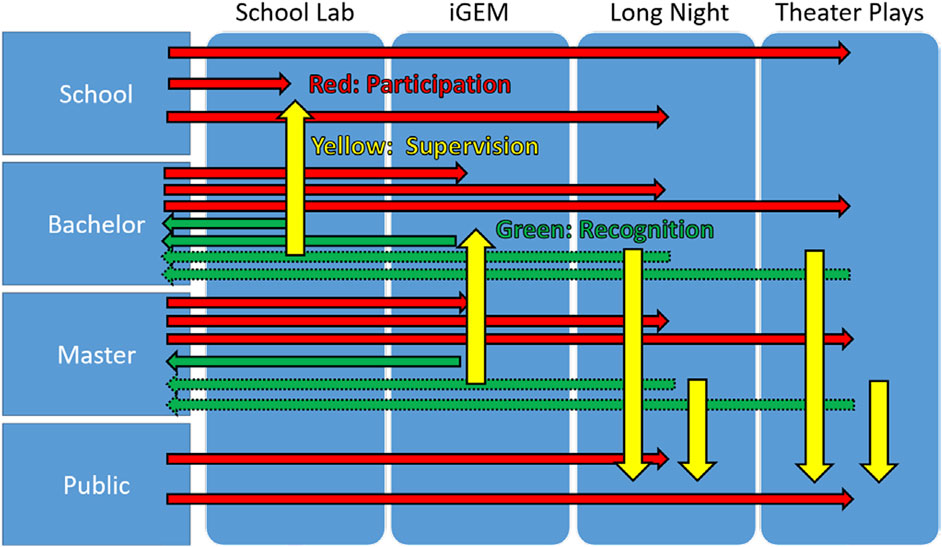
FIGURE 1. Flowchart model describing how high school students, Bachelor and Master students and the general public as our general target groups are guided through each of our activities, which include the electron microscopy student lab, the iGEM teaching module, the Long Night of the Sciences and theater plays. Red arrows represent participation, yellow arrows represent mentoring, and green arrows represent rewards for participation and/or supervision, which may be study credits or hold paid positions. Reproduced with permission.
Bachelor students are granted academic credits, represented by the green arrows, for supervising these labs, which is accounted for within their internship curriculum. In contrast, Master students typically hold paid positions, acknowledging their supervisory roles and more advanced involvement. Green arrows with dotted lines indicate possible recognition by student credits which, in our view, could be awarded but were not included in our case.
The module “iGEM–Synthetic Biology,” an elective within the study program of TU Berlin, is a research-based teaching initiative that encourages active participation from both, Bachelor, and Master students, each receiving academic credits in recognition of their contributions. However, there is a delineation of responsibilities; Master students more frequently assume supervisory roles, while Bachelor students engage in fundamental laboratory work and interdisciplinary projects, such as creating videos and web pages for science communication. Some Master students also take on additional responsibilities as student tutors with paid positions, providing intensive supervision.
The “Long Night of the Sciences,” an annual event, invites participation from students, pupils, and the public, fostering community engagement in scientific exploration. During this event, both Bachelor and Master students undertake duties during presentations and supervision. While participation in the Long Night of the Sciences is part of the “iGEM-Synthetic Biology” teaching module, the provision of special student credits for these activities, indicated by dotted green arrows, has not been implemented in our curricula but remains a consideration.
Theater plays are executed by Bachelor and Master students who also manage practical supervision of the public attendees. Participation in these special events is entirely voluntary, and while the acknowledgment through credits for participation and/or supervisory efforts is feasible, we have not yet established to do so.
The school lab for electron microscopy is a special institution in the institute of physics at MLU Halle. Bachelor students conduct high school student´s education there in the framework of the student internship for ongoing physics teacher. Such organization and supervision of a teaching day is recognized with student credits. Master students not yet achieve such credits but supervise high school students in the framework of paid positions.
In summary, the flowchart (Figure 1) describes our coherent framework for integrating science communication activities into academic curricula that emphasizes participation, supervision, and recognition through a system of credits. It emphasizes a hierarchical yet collaborative engagement across different educational stages, from school to public engagement.
Research-based teaching that incorporates scientific presentations and performances into the curriculum equips students with the tools to translate complex ideas into understandable language. By emphasizing the importance of clear, concise communication alongside scientific accuracy, this method grooms a group of scientists and professionals who can bridge the gap between the scientific community and the public. This is one reason why we have developed the student-centered and competition-based research module “iGEM-Synthetic Biology”, in which young students from all disciplines with little or no research experience are given the intellectual and scientific resources to develop into a confident, responsible, and independent research group targeting a highly specialized field that requires a wide range of skills (Schmitt et al., 2021a; Schmitt et al., 2021b). Student-centered courses, projects, and workshops that empower students to create and present their research programs are immensely motivating and hold significant educational, scientific, and societal value (Schmitt et al., 2017b; Schmitt et al., 2019b). “iGEM - Synthetic Biology,” introduced in 2014 at TU Berlin, provides a platform for students to grasp the fundamentals of synthetic biology while engaging in intricate laboratory work and sharing their findings with the public. They subsequently present their work in international competitions, either iGEM (iGEM, 2024) or BIOMOD (BIOMOD, 2024a).
Before starting into the semester, students have to apply for “iGEM-Synthetic Biology” and conduct a short interview explaining the motivation for their participation in this elective module. Generally, all applicants are allowed to participate, however, if resources are limited, such interviews can also be used to select the participants for the course. At TU Berlin the module is awarded 9 ECTS credits, equivalent to a student effort of 270 overall working hours (including homework).
The semester starts with a series of meetings in a weekly seminar initially explaining the module and all the expected outcomes in detail. The module is structured into this weekly seminar and freely organized laboratory work as well as a series of separate meetings to fulfill the mandatory achievements. These are the execution of a project in synthetic biology with free chosen topic, the documentation of all work in a lab book and a protocol, the presentation of all work and outcomes on a web page including a video of 3 minutes explaining the project and project outcomes (Youtube MultiBrane, 2023; YouTube Smart B.O.B., 2023) and the participation in either the annual iGEM competition in Boston (iGEM, 2024) or the BIOMOD competition in San Francisco (BIOMOD, 2024b). During the big Jamboree in these competitions, the students present their project outcomes on stage in the form of a presentation with character of a science slam including theatric elements.
“iGEM - Synthetic Biology” at TU Berlin begins with presentations of the work of former winning teams in iGEM or BIOMOD and small presentations from the supervisors’ showing publications of current research topics. Ideally the research of the working group and possible project suggestions are included in these presentations. Overall, the students refer to the current state of science, but are already trying to think beyond it - not necessarily focusing on a deep scientific approach, but in a broader sense of how to transfer current scientific findings to more general or even different problems out of the discipline. This sometimes involves a kind of “science fiction” but helps to find new approaches.
Students are usually presented with several proposals for possible research topics, but with an open outcome, as the projects are ultimately decided by democratic vote within the team and then refined and reshaped in an evolutionary process.
Once a team is finally formed (Figure 2) and a research topic is selected, students develop a hypothesis, a thorough research proposal with achievable goals, and determine specific research methods. During these processes, students use a range of digital resources, including online research archives, content management systems, digital documentation platforms, educational videos, project design tools and team management software. They also play an active role in maintaining project blogs and collaborative workspaces (Schmitt et al., 2017b; Schmitt et al., 2017c; Schmitt et al., 2017d; Schmitt et al., 2018; Schmitt et al., 2019b).
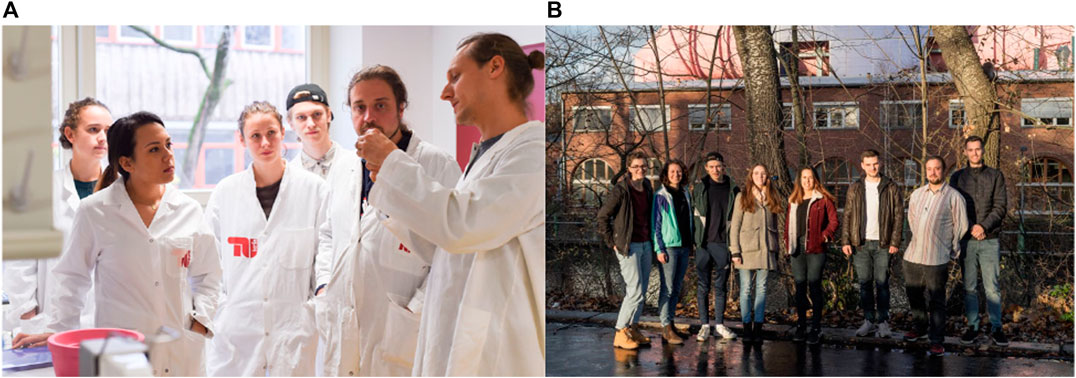
FIGURE 2. Students of the 2019 iGEM team “smart biologically optimized battery” (“smart B.O.B”) and their supervisors inside (A) and outside (B) the lab. Reprinted with permission from Schmitt et al. (2021). ©TU Berlin. Reproduced with permission.
The use of digital documentation and discussion platforms enables continuous assessment by supervisors but mainly contributes to a steady science communication via various online communication channels such as Facebook (Facebook, 2023), Instagram (Instagram, 2023) and Twitter (Twitter, 2023). These tools also support the development of project blogs and the creation of project-related videos which are mandatory to finalize the competition (YouTube Smart B.O.B., 2023).
The research project involves 10 to 15 participants organized into various working groups. At the project’s outset, participants share skills and preferences, with each group ideally led by a qualified expert. Financial support, crucial for competitions and lab work, is secured through university backing and additional funding from partners like the cluster of excellence Unifying Systems in Catalysis (UniSysCat) and the Society of Friends of the TU Berlin. For the BIOMOD competition in San Francisco in 2017, our project garnered significant recognition, earning a gold medal and ranking third in “Best Project” and “Best Video” categories. This success was the result of dedicated preparation, with students committing long hours in the lab and optimizing their online presence.
In our “iGEM–Synthetic Biology” educational module, students immerse themselves in a dynamic learning environment, translating diverse knowledge into concrete synthetic biology projects for international competitions like iGEM and BIOMOD. This hands-on experience not only activates their motivation but also fosters teamwork and presentation skills (Figures 2, 3) (Schmitt et al., 2021a). Beyond the major Jamboree events, students actively engage in activities like the Long Night of the Sciences, refining their science communication abilities. Taking an innovative approach, they blend theatrical presentations with digital components to creatively showcase their competition results on stage during the Jamboree.
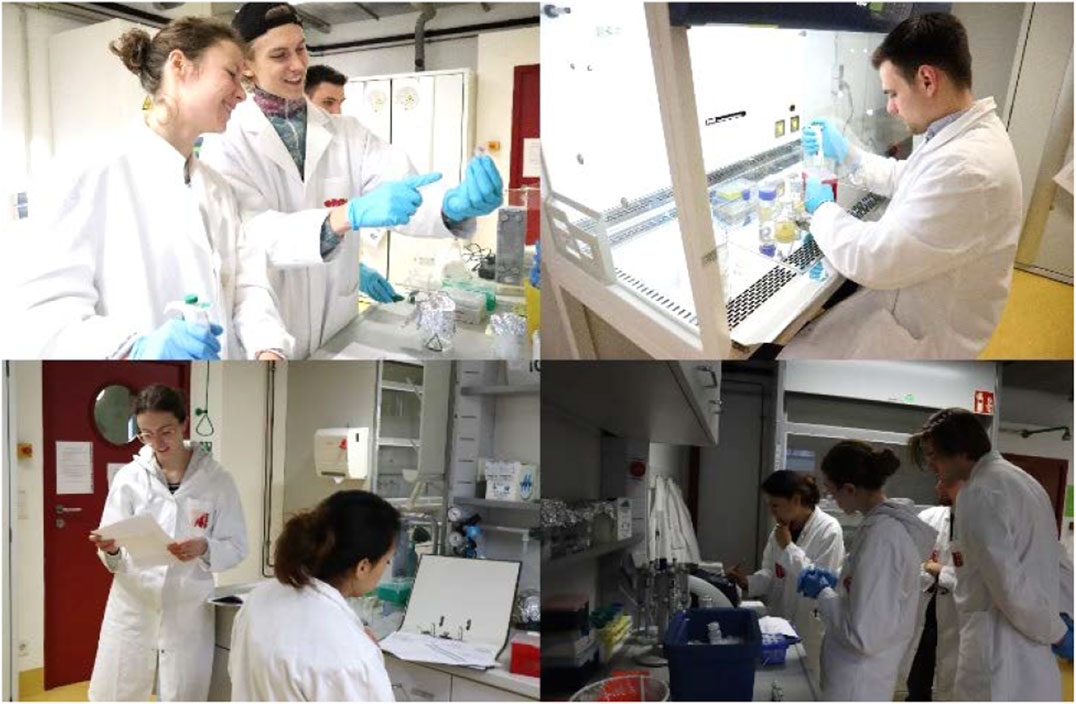
FIGURE 3. “iGEM–Synthetic Biology” students working in the laboratory at TUB. Reprinted with permission from Schmitt et al. (2021). Reproduced with permission.
“The Long Night of the Sciences” exemplifies dynamic science communication, breaking traditional academic barriers by offering a vibrant, interactive experience for the public. This global event opens the doors of universities and laboratories after dark, providing a unique platform for scientists to engage directly with the public. During the event, curious minds of the public are invited into spaces where science is usually cloistered away. The festival features interactive exhibitions, hands-on experiments, and captivating presentations, challenging scientists to communicate complex research in accessible ways. Utilizing this platform, our students from the iGEM-Synthetic Biology module present their projects, including synthetic biology and xenobiology, through various engaging formats. This integration not only allows students to refine their communication skills but also provides the public with insights into innovative projects, fostering an educational and inspirational dialogue. This hands-on approach is especially crucial in synthetic biology, where understanding genetic engineering, molecular biology, and bioethics is essential for informed public discourse.
The Long Night of the Sciences enables a direct, face-to-face exchange between scientists and the general public and fosters a sense of connection and understanding that often cannot be achieved through traditional communication methods (Schmitt et al., 2021a; Schmitt et al., 2021b; Ohlhausen et al., 2023). It is of great interest when events address not only the typical cognitive senses such as hearing and seeing, but also senses such as feeling, tasting and smelling, as such a combination of senses supports the learning process and promotes competence growth in recipients, as is specifically the case with the Long Night of the Sciences (Rosenblum, 2010; Ohlhausen et al., 2023).
For effective science communication, it is important to reach out to the public in innovative ways. Science slams are engaging presentations that cater to an eager audience, simplifying complex topics into entertaining and comprehensible formats. These events, originating from global competitions, have contributed to the emergence of edutainment as an innovative educational approach (Vogt, 2022). Science slams serve as key tools in science communication, primarily resonating with individuals with a pre-existing interest in science. But similar to the Long Night of the Sciences such mediums typically assume a certain level of scientific background knowledge as they often present scientific details explicitly.
While such events as the Long Night of Sciences and science slams appeal to those interested in science, it is a challenge to reach those who have no prior scientific knowledge or interest. Therefore, incorporating stories, especially through plays, offers a unique way. Plays combine scientific stories with compelling drama, making scientific concepts accessible and memorable. Unlike traditional formats, theater transcends the norms of scientific presentation, attracting a diverse audience, including those more inclined to the arts. The immersive experience of theater, as offered by the play “Life from the Toolbox” (Festival für Freunde, 2024d), transcends traditional science communication, engaging all the senses and fostering a deeper connection. Theater plays build a unique bridge between science and the public, providing an inviting space for exploring and reflecting on the wonders of science.
The Heinz-Bethge-Stiftung school laboratory for electron microscopy at MLU Halle provides an immersive educational environment for high school students to explore the micro- and nano-worlds. With a focus on hands-on learning, the laboratory features various light microscopes and scanning electron microscopes, enabling active engagement in experiments and sample preparation. Designed for project groups of around 12 high school students aged 14–19 years, the laboratory encourages personal connections by allowing students to bring their own samples. Staffed by Master’s students, the laboratory offers guidance throughout the scientific process. Notably, the laboratory includes a dissected 100 kV high-resolution electron microscope for a visual demonstration of transmission electron microscopy principles. Additionally, a macroscopic model illustrates atomic force microscopy, enhancing high school students’ understanding of contemporary scientific and industrial technologies. This approach not only fosters a deeper appreciation for microscopy but also provides foundational knowledge for high school students’ academic and professional journeys.
In 2017, the interdisciplinary “MultiBrane” student team of our teaching module “iGEM-Synthetic Biology” achieved remarkable success by securing third place globally in the BIOMOD competition (YouTube Multibrane, 2023). The team comprised students from diverse programs such as Biotechnology, Chemistry, Physics, Computer Science, Biochemistry, Mechanical Engineering, and Art, along with Bachelor students from the “MINTgrün” orientation program at TUB. Their project involved designing a modular biological membrane equipped with active fusion proteins. These proteins included esterase for erythromycin degradation (de Cazes et al., 2016), phytochelatins for heavy metal complexation (Cobbett and Goldsbrough, 2022), and cutinase for PET degradation (Martinez et al., 1992). These proteins were attached to bacterial flagellar axial proteins, creating a biological membrane capable of purifying water by binding appropriate enzymes to remove pollutants like microplastics, antibiotics, and heavy metals (Vonderviszt and Namba, 2023). The team meticulously characterized their construct by integrating the green fluorescent protein and employing fluorescence lifetime imaging microscopy, an effective method for characterizing fluorescent hybrid systems (Schmitt et al., 2011; Schmitt et al., 2014; Schmitt et al., 2017a; Schmitt et al., 2019a; Schmitt et al., 2021a; Schmitt et al., 2021b; Tejwani et al., 2017).
This journey underscored the students’ remarkable motivation and unwavering commitment to tackle highly intricate projects, including an extraordinary and motivated engagement in the laboratory (see Figure 3). Notably, our teaching module has been acknowledged for its exceptional pedagogical approach, receiving recognition in 2018 from the Society of Friends of the TU Berlin e.V. in form of the TU teaching award (TU Berlin, 2023).
In 2019, TUB has integrated “iGEM–Synthetic Biology” into a major teaching campaign initiated by the Vice President for Teaching, Prof. Dr. Hans-Ulrich Heiß, with a special focus on “Research-Based Learning”. In the following we will in detail describe the project of the 2019 iGEM team “smart B.O.B.” that used synthetic biology to develop a biologically optimized battery (B.O.B.).
The 2019 iGEM team “smart B.O.B.” decided to develop a biological battery using photosynthetic cyanobacteria capable of generating electricity through macroscopic electrode potential changes in a specially designed growth cell (see Figure 4). The driving force behind this project was the desire to contribute to the development of regenerative energy sources.
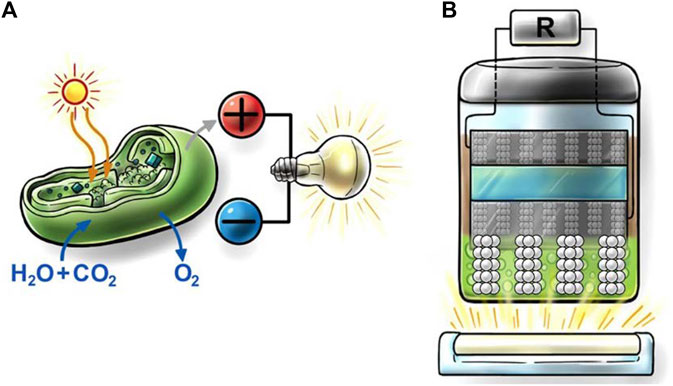
FIGURE 4. (A): Basic idea of a biological battery driven by photoautotrophic cyanobacteria, (B): Simplified construction of an electrochemical growth cell based on commercially available “mud watts” (MudWatt, 2023). Reprinted with permission from Schmitt et al. (2021). Reproduced with permission.
The project focused on the use of photoautotrophic cyanobacteria, which, like plants, use solar energy to synthesize organic compounds from atmospheric CO2. The overall goal was to improve the technology in such a way that an electric current is obtained as described by Haas et al. by guiding the electrons released during photosynthesis into an electric circuit (Haas et al., 2018). Several strategies exist to optimize this process starting from the structured electrodes in the growth cells (Saper et al., 2018) up to genetic engineering to increase the efficiency of the electron transport chain to the extracellular milieu (Hu et al., 2020) and to improve bacterial adhesion to the metal electrodes.
Our concept aligns with the electrochemical workstation model developed by the Adir research group (Saper et al., 2018). This approach employs carbon membranes and a carbon fiber mesh as a conductive foundation for the photosynthetic cyanobacterium Synechocystis sp. PCC 6803. These microorganisms are well characterized and are amenable to genetic manipulation. This approach shares similarities with recent proposals where conductive matrices are enriched with vital nutrients to support bacterial growth, creating an optimal environment for the development of biological batteries (Hu et al., 2020).
For our approach, we utilized a commercial carbon electrode system provided by MagicalMicrobes® that generally facilitates the cultivation of the electrochemically active bacterium Shewanella oneidensis, an electrophilic bacterium, in a vessel filled with common soil (See Figure 4). This results in the generation of nearly 1 V of voltage between the electrodes, which can be utilized to power electronic circuits containing components such as LEDs or small electric clocks. MagicalMicrobes® offers this system to educational institutions like schools and universities, and it seemed well-suited for our purposes to grow the photosynthetic cyanobacterium Synechocystis sp. PCC 6803. (MudWatt, 2023) (Figure 4).
Figure 5 shows the implementation of the growth vessels into an illumination system in our laboratory with continuous monitoring of the voltage and current generated as a function of the applied light intensity.
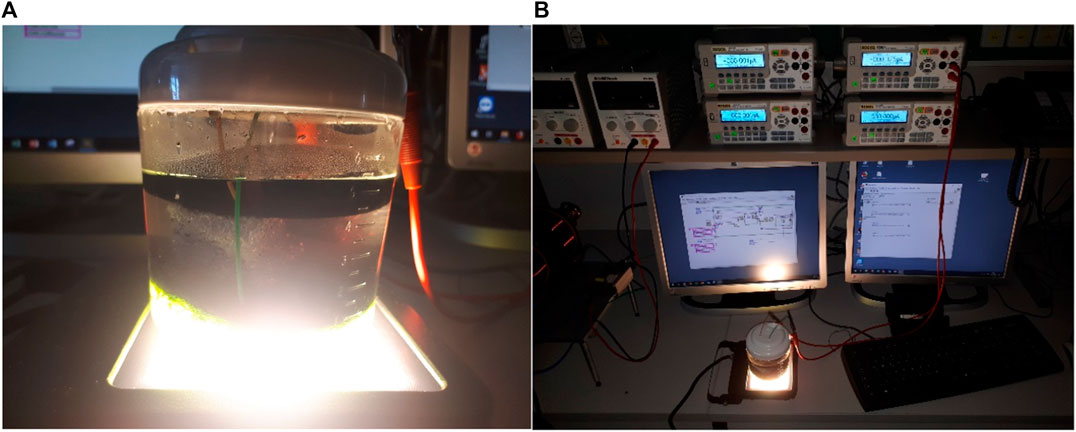
FIGURE 5. The growth cell under illumination (A) and the setup suitable to monitor current and voltage during on-off periods of illumination (B). Reproduced with permission.
On the BIOMOD Jamboree, finally, the team presented its research not only through traditional oral presentations, but also in the form of a theatric play (see Figure 6). Within 10 minutes, the teams must ingeniously communicate their research by balancing scientific rigor with artistic expression. This imaginative approach to science communication incorporates elements of storytelling and engages the audience on a profound level. As teams may use dramatic components, props, and imaginative narratives to convey the background, goals, methods, results and conclusions of the project, the team smart B.O.B. decided to start with climatic changes and the risk of resources exploitation to motivate their project. One student played the cyanobacterium Synechocystis sp. PCC 6803 that was enabled to produce electrons after genetic engineering of the proteins involved in the electron transport chain resulting in a transformed bacterium containing electron carriers suitable to transfer the electrons across the thylakoid membrane, plasma and outer membrane of the cells.
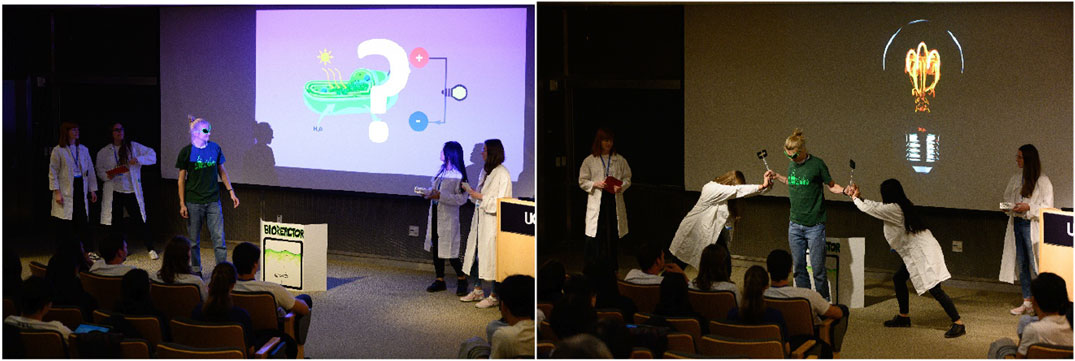
FIGURE 6. Photos that convey the impressions of the presentation at the University of California, San Francisco. Photography: Jeff Rumans. Reproduced with permission.
The theatrical side of the presentation creates a dynamic and memorable experience and promotes a multifaceted understanding of the project that goes beyond traditional scientific discourse. This method enriches science communication by appealing to emotions, imagination, and intellectual curiosity, making synthetic biology not only understandable but also captivating for different audiences.
Collectively, the public project outcomes, presented on the website, with videos and during the presentations (Youtube MultiBrane, 2023; YouTube Smart B.O.B., 2023), enhance science communication by catering to diverse learning styles and levels of knowledge. The project website offers an extensive resource for individuals seeking in-depth information, the YouTube video provides a concise overview for a broader audience, and the Jamboree presentations facilitate real-time interaction and engagement with all participating teams. Through these initiatives, the BIOMOD competition effectively maximizes the dissemination of scientific knowledge, rendering it accessible, informative, and engaging for a broad spectrum of stakeholders. In doing so, it fosters public comprehension and appreciation of the intricacies of biomolecular design within the realm of synthetic biology.
The development of presentation skills is an integral part of the comprehensive project framework in the teaching module “iGEM-Synthetic Biology”. The students organise and give their own presentations in seminars. They also actively participate in academic events such as the Forsch2017 conference at Humboldt-Universität zu Berlin, a platform specifically designed for the presentation of student projects.
In addition to these academic activities, the students also present their projects at city-wide and national events, such as the “Long Night of the Sciences”. This event is an exceptional opportunity for students as their work is presented to an audience that can reach up to 3000 people (reached in 2019) in an open and accessible science communication format (see Figure 7).
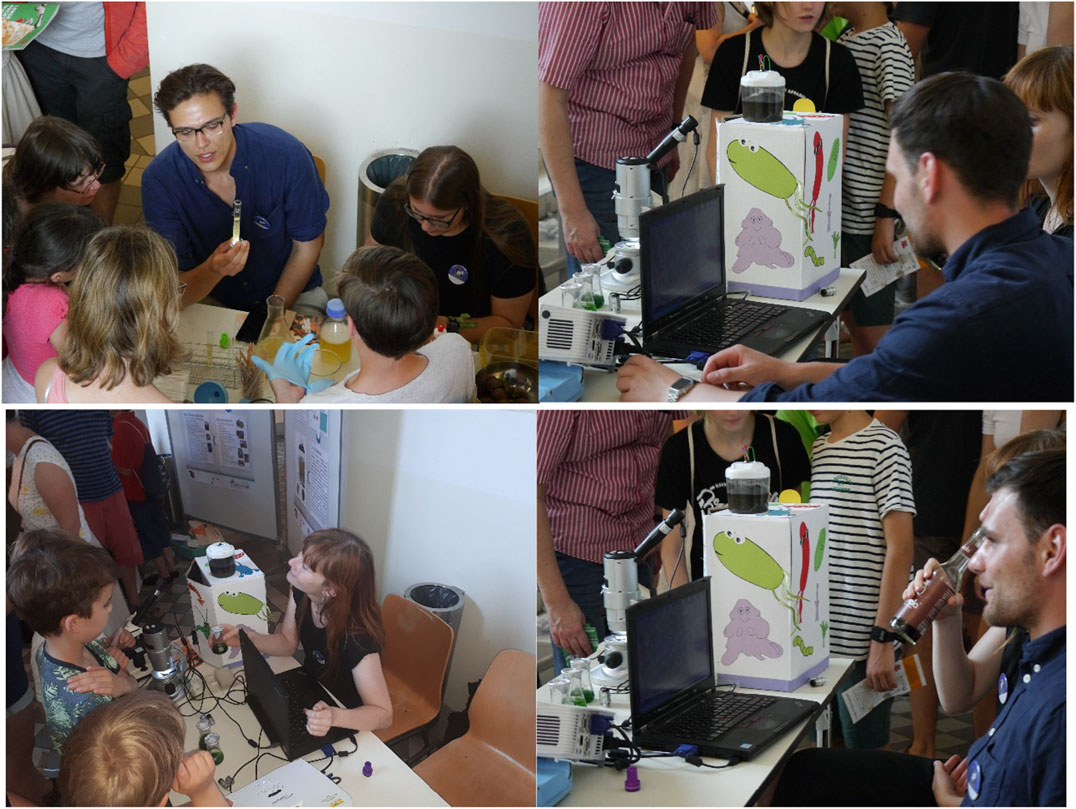
FIGURE 7. Presentation of the „Smart B.O.B.” project during the Long Night of the Sciences 2019 at the TU Berlin. Reprinted with permission from Schmitt et al. (2021). Reproduced with permission.
Participating in the Long Night of Science is a valuable practice for synthetic biology science communication, offering hands-on demonstrations and interactive discussions. This event provides a unique platform to showcase genetic engineering, biomolecular design, and other applications, creating lasting impressions and enhancing public appreciation for the field. Interactive activities like DNA extraction and microbial culture observation engage the audience, fostering knowledge acquisition. Beyond scientific accomplishments, the Long Night of the Sciences facilitates open dialogues on the ethical, environmental, and societal implications of synthetic biology. Engaging with the public, especially young students, during this event has the potential to inspire the next-generation of scientists. Scientists in synthetic biology become mentors, contributing to narrowing the educational gap in STEM subjects and igniting passion for science among prospective students.
To sum up, participation in the Long Night of the Sciences stands as a highly effective avenue for science communication within the realm of synthetic biology. It enables scientists to interact with the public, exhibit their work through interactive displays, foster interdisciplinary collaborations, facilitate ethical discussions, and serve as sources of inspiration for future scientists. This engagement not only educates the public but also cultivates a deeper comprehension and appreciation of the potential and significance of synthetic biology in addressing real-world challenges.
In 2023, with support from the Ministry of Science, Research and Culture of Brandenburg, Germany (MWFK), an innovative theatrical production called “Life from the Toolbox” was developed for the “Festival for Friends” 2023. This annual arts event, located in a picturesque village 90 km south of Berlin, aimed to immerse the audience in the intricacies of synthetic biology. The play featured a mix of elements, weaving together a narrative that explored the genetic transformation of tomato plants. It also delved into the societal implications of synthetic biology, questioning whether it could effectively address challenges like climate change or the energy crisis.
The theater play is developed according to the “sandwich” structure (Cai et al., 2022) that interrupts informative and theoretical elements in form of collective and individual “learning” as interactive theater sequences and readings or immersive movies and additional teaching videos to support the individual understanding of synthetic biology and the content of the theater play in detail.
The play has an additional story behind synthetic biology and it´s possible application as it highlighted the protagonist scientists’ focus on self-interest or interests of a small elite in general that wants to profit from synthetic biology and gather advantages for themselves, such as extending lifespans and optimizing humans, rather than addressing broader issues like energy production, healing of global diseases or world hunger. While it portrayed synthetic biology as somewhat elitist, it ended on a positive note. In detail, the dramaturgy was constructed as follows:
The performance began with a prologue explaining basic concepts such as the genetic code and bacterial transformation. This foundational scene sets the stage for the narrative that was to unfold, framing the ensuing acts within the context of synthetic biology’s basic principles.
In the subsequent act, an on-stage experiment simplified the process of DNA extraction from tomatoes, bringing the laboratory to the theater and demystifying the initial steps of genetic analysis. This scene bridged the gap between scientific procedure and audience comprehension, making the abstract tangible.
In a captivating theatrical segment, a performer disassembled a tomato and reassembled it in a new configuration, finally consuming the interior of the tomato which obviously impacted the body culminating in a rhythmic dance performance (see Figure 8). The dance symbolized the transformative effects of genetic manipulation on the body. This powerful visual metaphor for the impact of synthetic biology on organic life served to connect the audience with the concept on a sensorial level, beyond intellectual understanding.
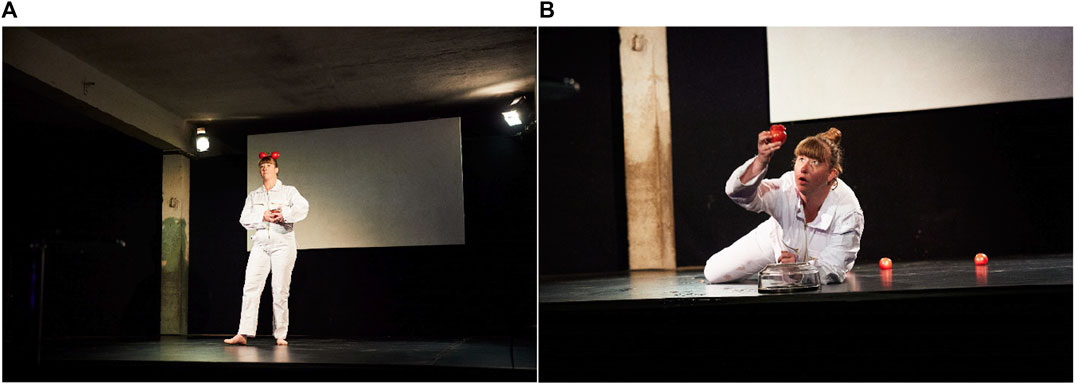
FIGURE 8. Woman in a white dress brings in tomatoes (A). After decomposing a tomato it is recomposed and presented to the audience (B). Photography: Finnegan Koichi Godenschweger. Reproduced with permission.
The next sequence was a scientific demonstration involving the visualization of DNA through fluorescent labelling and light microscopy. The audience was shown the bright yellow fluorescence of Na-fluorescein in chemical glass tubes and its application in DNA labelling for microscopic visualization. The production ended with authentic microscopic images of DNA projected for the audience, giving the illusion that isolated tomato DNA was visible to the naked eye, leaving a lasting visual imprint (see Figure 9).
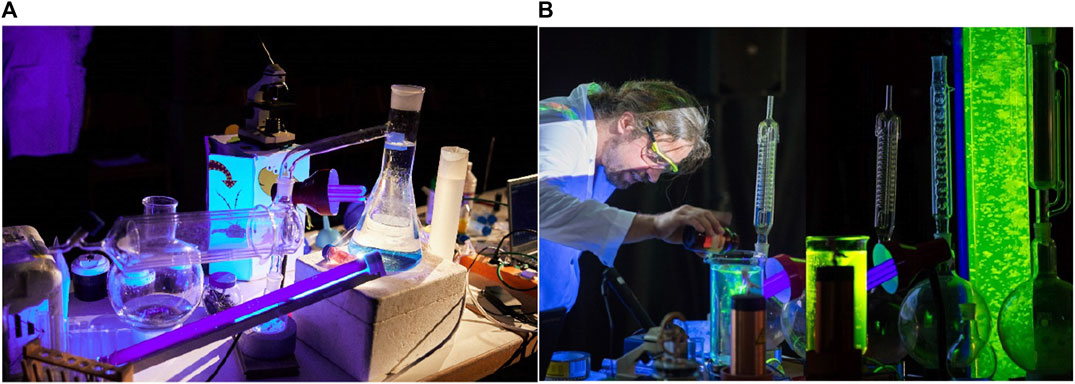
FIGURE 9. The scientist in “life from the toolbox” has built up a laboratory on stage (A). With fluorescein in UV-light he is marking solutions in chemical vessels to generate an exciting and immersive atmosphere (B). Photography: Finnegan Koichi Godenschweger. Reproduced with permission.
A video presentation augmented the narrative with microscopic images overlaid with genetic code letters, artistically reinforcing the connection between genetics and the physical characteristics of organisms. This fusion of art and science offered a compelling visualization of the genetic underpinnings of life.
In the following segment, a futuristic game show scenario was narrated in which the participant had to answer complex questions about synthetic biology. Interestingly, the participant in this game show was one of the few unchanged people in a dystopian future where all human beings are genetically modified.
During the course of the narrative, the audience was introduced to various concepts and applications of synthetic biology. As the plot unfolded, the candidate transformed into a rebel who wanted to challenge a dystopian society where the wealthy could enhance their biological traits through genetic modification. His goal was to destroy the grand prize, a device that would allow to introduce genetic modifications into humans. In response to his opposition, the show’s host asked an unanswerable question designed to make him lose the television quiz and leave him empty-handed.
A virtual genetic transformation of a tomato was then carried out in another laboratory scenario, illustrating the basic steps of genetic modification. The gene sequences were intended to bring improvements to the human body and potential solutions to environmental and medical challenges such as combating climate change, curing cancer, alleviating world hunger and reducing child mortality. However, the experimenter in the lab was primarily concerned with selecting the improvements he wanted to introduce for himself. His focus was on extending his life span culminating in a scene where he voraciously engulfed the mutant tomato because it was promising eternal life.
The most important plasmid seemed to be a gene code for immortality, which was successfully integrated into the tomato. After the tomato had successfully grown, the experimenter greedily consumed it, symbolising his insatiable thirst for immortality, while the global benefits of synthetic biology faded into the background.
In the following scene, a woman appeared with tomatoes in her hand and pressed them onto her naked body, creating a sombre atmosphere of self-destruction. As the tomatoes ran down her body and fell to the ground, this conveyed a sense of the tomatoes’ futility and mortality. This representation emphasised that the tomatoes were not used to solve global problems, but were selfishly consumed by an elite group with access to the tools of synthetic biology and the toolbox of life. They ultimately focused on the immortality gene that had been introduced into the tomato, underscoring their fixation on self-preservation and their disengagement from broader societal concerns.
In the closing scene, a collection of bagels was presented, and they were cut into smaller pieces and adorned with various toppings, such as fresh cheese and tomatoes. The intention was to offer these bagel slices to the audience for consumption. However, before doing so, the scientist reassembled these pieces in a novel manner while explaining the necessity of combining the different elements like cancer treatment with blond hair and blue eyes, ending world hunger with more physical strength, addressing climate change with an artificial synthetic super brain, and reducing child mortality with personal immortality.
Overall, the scene conveyed the idea that the pursuit of saving the world and improving conditions for the less fortunate was intertwined with the distorted desire for personal advantages up to immortality among the elite. These reconfigured bagel slices were then served to the theatre play’s audience, who were invited to partake in consuming them (and some of them complied).
After the theatre play, a discussion was held with the audience to explain details and, most importantly, to answer their questions.
In “Life from the Toolbox” art and the science of synthetic biology converged into a theatre play featuring lab events, readings, films, and dance sequences, followed by discussions (Festival für Freunde, 2024b). We established a network of artists and scientists, integrating art and science into the Festival for Friends. Detailed content is available on our website (Festival für Freunde, 2024a), including educational videos covering essential topics like synthetic biology, bacterial transformation, protein biosynthesis, viruses, vaccinations, gene transcription, and synthetic biology’s role in vaccine development. This additional videos communicate the basic background of synthetic biology and allow the audience to understand the play intuitively, preserving its artistic value. For example, the audience may symbolically link the bagels they consume during the performance to gene plasmids, leading to an unconscious exploration of the play’s themes and concepts.
The theatre production “Life from the Toolbox” distinguishes itself by combining explanatory science and visual performance in a unique manner. It simultaneously promotes knowledge acquisition and immersive artistic perception, enabling the audience to grasp the content engagingly without the need for purely scientific enlightenment. There is also a strong connection to the local context, particularly the engaged rural community. Over the past decade, this community has consistently shown interest in innovative artistic performances at the festival. However, they may not typically possess the same level of prior knowledge about scientific topics as students from Berlin, who are often involved or at least well-informed about current trends in science.
The project plays a formative role in the Planetal region of Brandenburg, Germany. Our digital presence on social media platforms (Festival für Freunde, 2024a; Festival für Freunde, 2024c) is complemented by a series of newspaper articles (Märkische Allgemeine Zeitung, 2023), which now regularly cover our projects. This ensures the wide reach of our digital communication strategy, serving as a bridge between visual performance and scientific art.
The theatrical medium transcends the conventional formats of scientific presentation, tapping into the universal human experience of storytelling and drama. This approach can captivate those who might not have a predisposed interest in science or who may find formal scientific settings inaccessible or intimidating. In a theater setting, the audience is invited to witness science not as a collection of facts and figures but as a dynamic story filled with character development, conflict, and resolution. This form of storytelling can make scientific concepts more accessible and emotionally engaging, fostering a connection that might otherwise be difficult to achieve. Therefore, especially theater plays have the potential to bridge the gap between the scientific community and the general public, creating a welcoming environment for all to explore and reflect upon the wonders and complexities of science.
The Heinz-Bethge Foundation for applied electron microscopy has initiated a remarkable endeavor to support young scientists through the “Electron Microscopy School Laboratory” at Martin-Luther-University Halle-Wittenberg (Heinz-Bethge-Stiftung, 2023). This laboratory primarily serves high school students in grades 10 to 12, providing an engaging introduction to light microscopy, electron microscopy, and various microscopic fields within biology, medicine, and the natural sciences (see Figure 10). During these typically half-day courses, students explore a wide array of fascinating samples, ranging from insects to microchips, as well as scientific samples from material sciences (see Figure 11). They get hands-on experience preparing and observing their samples, first with a light microscope and later with an electron microscope. This practical work on large physical equipment aims to motivate the participating high school students to develop a passion for STEM (science, technology, engineering, and mathematics) subjects (see Figure 10).
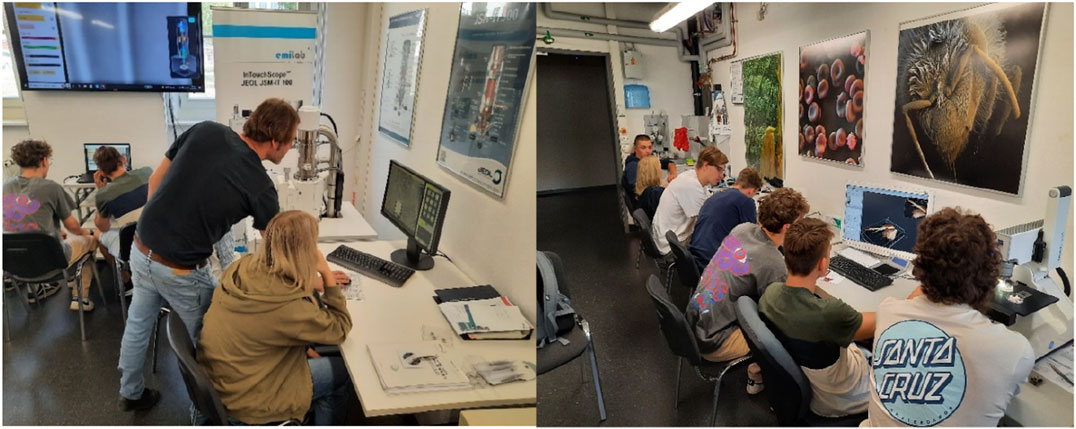
FIGURE 10. Teaching courses take place in the student laboratory for electron microscopy at the Heinz-Bethge-Stiftung, focusing on applied electron microscopy at Martin-Luther-University Halle-Wittenberg. Reproduced with permission.
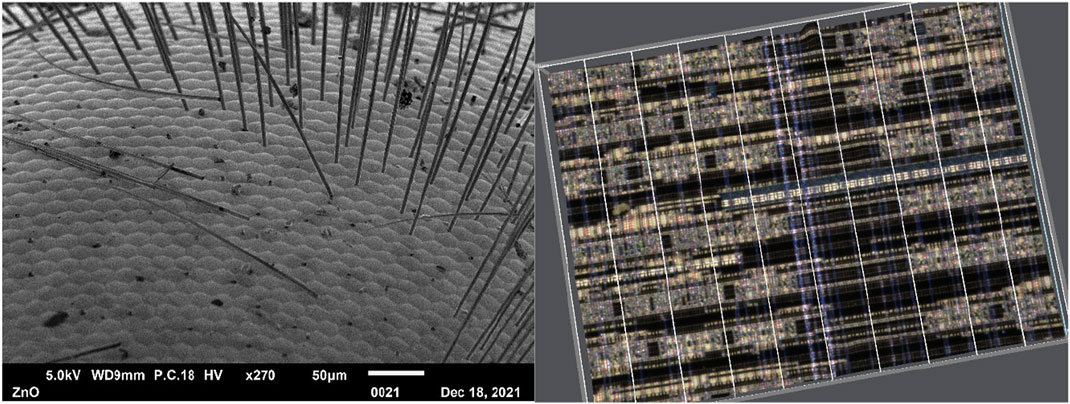
FIGURE 11. These photos illustrate the combined investigations of biological samples (depicted on the left side, featuring a fly’s eye) and microchips (visible in the light microscope on the right side). This direct connection between biology, computer science, and material sciences is designed to cultivate an innovative approach for high school students to comprehend synthetic biology. Reproduced with permission.
Considering the evolving landscape of student interests, influenced in part by societal changes, and recognizing the gaps in science education at the school level, it becomes evident that there is an urgent need to spark curiosity in young minds. The “Electron Microscopy School Laboratory” serves as a bridge between science and our youngest learners, addressing this need effectively.
The lab’s core mission is to demystify scientific research for students, especially those who may initially approach science with hesitation or fear. This is particularly important in the context of synthetic biology, a field that can seem daunting, especially to older individuals who are unfamiliar with it. In contrast, younger children are naturally curious and enthusiastic about challenging topics like synthetic biology. The lab breaks down barriers by allowing students to interact directly with electron microscopy tools, sparking their interest and helping them understand the profound impact of synthetic biology across various fields.
Beyond traditional classrooms, the lab creates an immersive and interactive environment where students can ask questions, challenge assumptions, conduct their own research, and explore scientific concepts firsthand. It instills the idea that science is not just a static body of knowledge but a dynamic, ever-evolving entity that invites active participation. Moreover, the “Electron Microscopy School Laboratory” is not just an educational facility; it is a nurturing environment where passionate educators serve as role models and mentors. They impart scientific knowledge and ignite a lifelong passion for learning and inquiry. Mentorship fosters a supportive community that motivates students to excel in science.
In conclusion, the “Electron Microscopy School Laboratory” provides a transformative experience that bridges the divide between science and young learners. Through early science communication, it demystifies the intricate world of synthetic biology and instills confidence and curiosity in the hearts and minds of our future scientists. In doing so, it plays a significant role in nurturing a new generation of STEM enthusiasts who are well-prepared to tackle the challenges of the future with a profound sense of wonder and purpose.
Guided by Humboldt’s philosophical ideal, our educational approach combines pedagogy and scientific research. We believe that optimal learning arises from the convergence of epistemological curiosity and scientific mastery and forms the basis for scientific pedagogy. Effective education trains not only capable researchers, but also communicators of scientific knowledge who can bridge the gap between a scientifically literate population and a skeptical public. Universities face the important task of preparing students for global challenges and effective communication on topics such as climate change, social cohesion, artificial intelligence, and reliable internet information. Cognitive engagement, which includes systematic inquiry, problem formulation, resource exploration and reflection, requires a hierarchy of skills. These skills thrive in a structured, modular, and project-based learning framework that emphasizes iterative training cycles, experiential learning and adaptation. Science communication plays a crucial role in communicating the complexity of learning and research and countering the misconception that science is a straightforward, one-way progression.
In the future, research-oriented, project-based courses offer the opportunity to revolutionize the educational landscape, especially in the context of new concept development including science communication. They address the urgent need to equip students with basic skills that will prepare them for future professional challenges. This kind of problem-solving competence should have a high priority in education. To achieve this goal, innovative pedagogical methods need to be developed and put into practice. This applies to theoretical subjects such as mathematics (Schmitt et al., 2015; Aljanazrah et al., 2017; Schmitt et al., 2017c), but also to empirical subjects, including internships (Schmitt et al., 2017d). These can be seamlessly integrated into project-based and research-oriented learning frameworks such as project labs (Huber et al., 2009; Ifenthalter and Gosper, 2014; Mieg and Lehmann, 2017; Schmitt et al., 2018; Schmitt et al., 2019b; Schmitt et al., 2021a; Schmitt et al., 2021b).
This paper presents an in-depth exploration of effective strategies for communicating the intricacies of synthetic biology. The overarching aim is to bridge the existing gap between the scientific community and segments of the general public who may not possess a primary education in synthetic biology or related fields. The motivation behind this research stems from the recognition that synthetic biology, a complex and rapidly evolving discipline, is not confined solely to scientific circles but bears profound implications for society at large. Table 1 gives an overview on project related websites and the corresponding internet links.
To effectively disseminate knowledge and inspire interest among diverse groups, we have devised a multifaceted approach encompassing four distinct communication strategies:
Central to this strategy was the creation of an educational module, “iGEM-Synthetic Biology,” hosted at TU Berlin. The primary objective here is to pique the interest of students hailing from a broad spectrum of academic backgrounds, many of whom may have limited prior exposure to synthetic biology. By engaging students in the design and realization of novel constructs in synthetic biology, we seek to demystify the field and make it accessible. The student centered project allows for the definition of an own research question and laboratory program, to develop solutions on self-developed questions and enable self-efficacy. Importantly, students are tasked not only with the technical aspects but also with the challenge of effectively communicating their projects. This entails performative presentations at the prestigious iGEM or BIOMOD competition Jamboree and the development of web pages and YouTube videos aimed at elucidating project details for the public. Through this approach, we hope to motivate students from different subjects to get educated and engaged in synthetic biology.
The annual “Long Night of the Sciences” event at TU Berlin and MLU Halle provides an ideal platform to engage with a diverse audience, many of whom may not possess prior expertise in synthetic biology. During this event, students and supervisors from the iGEM module undertake active efforts to present their results through a series of interactive and performative presentations. These include quizzes, on-stage experiments and presentations, informative posters and slide shows, and especially discussions, designed to captivate and educate individuals from various walks of life. Through this approach, we hope to cater to individuals visiting the Long Night of the Sciences who are not primarily educated in synthetic biology.
Our collaboration with the “Festival für Freunde e.V.” represents an innovative endeavor to create a space for interactive and aesthetic dialogue between scientists, artists, and the general public. At the heart of this initiative lies the theater play “Life from the Toolbox,” which artfully conveys the genetic modification of tomatoes while providing an in-depth exploration of synthetic biology. Additionally ethical questions like the accessibility of the advantages of synthetic biology for all people in the world, are discussed. The use of readings and a series of instructional videos serves to make the complex subject matter accessible and the theater play understandable. This interdisciplinary theater play, developed through a workshop series that brought scientists and artists together, demonstrates our commitment to reaching individuals who may not have a primary education in synthetic biology and furthermore are not even aware that they undergo a scientific education as they are on their way as visitors of a cultural festival.
School laboratories are pivotal in bridging the gap between science and young learners. They offer hands-on science experiences, inspiring confidence and curiosity. These labs provide an interactive environment where students engage with peers and enthusiastic mentors, promoting critical thinking and problem-solving skills. Early exposure to real-world relevance and inclusivity ensures that all students, regardless of background, can explore the wonders of science, fostering a lasting love for inquiry and discovery.
In sum, these meticulously designed communication strategies represent our concerted effort to bridge the gap between synthetic biology and pupils, students, scientifically interested public and the broader public, especially those who may not possess any foundational education in the field. By embracing an inclusive approach, we aspire to foster a more informed, engaged, and collaborative discourse around synthetic biology and its societal implications. Perhaps most importantly, these strategies are forging a path toward a society of informed citizens. As more individuals gain insights into synthetic biology, the potential for collective decision-making and responsible stewardship of biotechnological advancements becomes increasingly tangible. We anticipate that the next-generation of scientists, artists, and citizens will be better equipped to engage with and shape the ethical and practical dimensions of synthetic biology.
Table 2 gives a comprehensive overview emphasizing the positive impact of each activity type on students’ educational experiences and its contribution to enhancing the broader public’s understanding and engagement with science. The table also indicates the necessary pre-educational level for participating pupils or students, along with specifying the target group of the outreach components, which includes the general public.
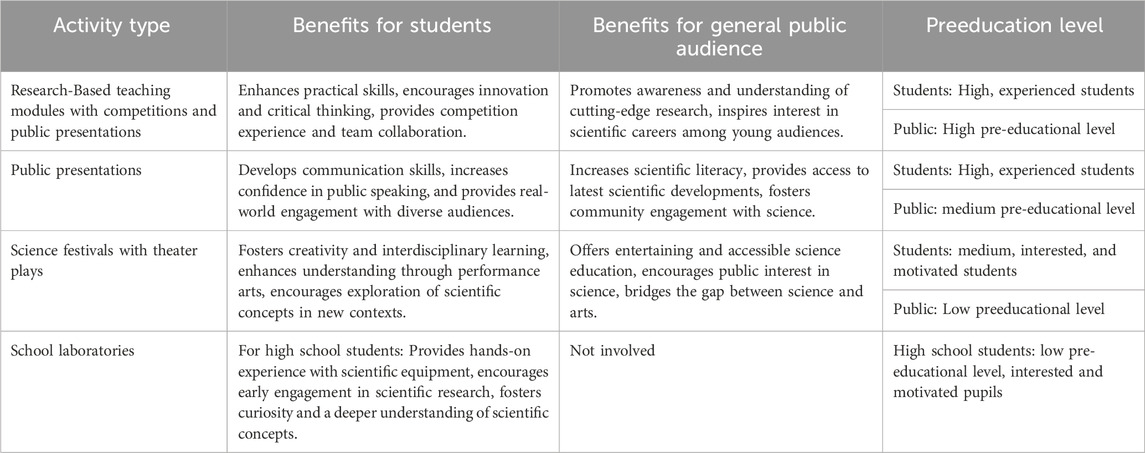
TABLE 2. Summary table that categorizes the four types of activities and outlines the benefits for both students and the general audience as well as their pre-educational level.
A sound democratic process depends on informed voters who are able to make decisions based on a comprehensive understanding of complex issues, including those arising from scientific developments. Effective science communication is the critical link between the scientific community and the public, policymakers and other stakeholders. When scientific advances are communicated effectively, they become part of the public discourse and enable people to understand the nuances and implications of research developments. This understanding is critical for informed decision making in voting, policy support and engagement in societal debates. Science communication is not just about disseminating knowledge, but also about enabling individuals to decipher the complexity of scientific information and its relevance to everyday life. The more science advances, the more important clear communication becomes to ensure that voters can advocate for science-based and socially responsible policies. This collective effort is crucial for a future in which political action is guided by informed debate and a deep understanding of the transformative power of science.
Written informed consent was obtained from the individual(s) for the publication of any potentially identifiable images or data included in this article.
F-JS: Conceptualization, Data curation, Formal Analysis, Funding acquisition, Investigation, Methodology, Project administration, Resources, Supervision, Visualization, Writing–review and editing. MG: Methodology, Project administration, Resources, Supervision, Writing–review and editing. NB: Conceptualization, Data curation, Formal Analysis, Funding acquisition, Investigation, Methodology, Project administration, Resources, Supervision, Validation, Writing–review and editing.
The author(s) declare financial support was received for the research, authorship, and/or publication of this article. The project was funded by Ministery of Science, Research and Culture of Brandenburg, Germany (MWFK, DIWA program, Projekt Neue Ästhetiken–Digitale Kommunikation), Deutsche Forschungsgemeinschaft (DFG) (UniSysCat, Cluster of excellence), Gesellschaft von Freunden der TU Berlin e.V. Rights in the cited material are owned by a third party.
Support by Martin-Luther-Universität Halle-Wittenberg is highly acknowledged. Grafical support by Florian Schmitt for Figure 4 is acknowledged.
The authors declare that the research was conducted in the absence of any commercial or financial relationships that could be construed as a potential conflict of interest.
All claims expressed in this article are solely those of the authors and do not necessarily represent those of their affiliated organizations, or those of the publisher, the editors and the reviewers. Any product that may be evaluated in this article, or claim that may be made by its manufacturer, is not guaranteed or endorsed by the publisher.
Aljanazrah, A., Schmitt, F.-J., and Friedrich, T. (2017). “Evaluation of the use of flipped classroom based tutorials in “mathematics for chemists” course from students`perspective,” in Research highlights in education and science. Editors M. Pehlivan, and W. Wu (Ames, Iowa, USA: ISRES Publishers), 150–155.
Andrianantoandro, E., Basu, S., Karig, D. K., and Weiss, R. (2006). Synthetic biology: new engineering rules for an emerging discipline. Mol. Syst. Biol. 2 (1). doi:10.1038/msb4100073
BIOMOD (2024a). BIOMOD official website. http://biomod.net/(accessed on 2024 June 16).
BIOMOD (2024b). BIOMOD web page. http://biomod.net/winners/2017.html (accessed on 2024 June 16).
Bonwell, C. C., and Eison, J. A. (1991). Active learning: creating excitement in the classroom. ASHE-ERIC higher education report No. 1. Washington, D.C.: The George Washington University, School of Education and Human Development.
Budisa, N. (2014). Xenobiology, new-to-nature synthetic cells and genetic firewall. Curr. Org. Chem. 18 (8), 936–943. doi:10.2174/138527281808140616154301
Budisa, N., Kubyshkin, V., and Schmidt, M. (2020). Xenobiology: a journey towards parallel life forms. ChembBioChem 21 (16), 2228–2231. doi:10.1002/cbic.202000141
Cai, X., Peng, M., Qin, J., Zhou, K., Li, Z., Yang, S., et al. (2022). Sandwich teaching improved students' critical thinking, self-learning ability, and course experience in the Community Nursing Course: a quasi-experimental study. Front. Psychol. 13, 957652. doi:10.3389/fpsyg.2022.957652
Chuang, S. (2021). The applications of constructivist learning theory and social learning theory on adult continuous development. Perform. Improv. 60 (3), 6–14. doi:10.1002/pfi.21963
Cobbett, C., and Goldsbrough, P. (2002). Phytochelatins and metallothioneins: roles in heavy metal detoxification and homeostasis. Annu. Rev. Plant Biol. 53, 159–182. doi:10.1146/annurev.arplant.53.100301.135154
de Cazes, M., Belleville, M.-P., Petit, E., Marcano, S., Bayer, S., Czaja, R., et al. (2016). Erythromycin degradation by esterase (EreB) in enzymatic membrane reactors. Biochem. Eng. J. 114, 70–78. doi:10.1016/j.bej.2016.06.029
Diwo, C., and Budisa, N. (2019). Alternative biochemistries for alien life: basic concepts and requirements for the design of a robust biocontainment system in genetic isolation. Genes 10 (1), 17–32. doi:10.3390/genes10010017
Endy, D. (2005). Foundations for engineering biology. Nature 438 (7067), 449–453. doi:10.1038/nature04342
Facebook (2024). Facebook web page:. https://www.facebook.com/igem.berlin/(accessed on 2024 June 16).
Festival für Freunde (2024a). Facebook web page:. https://www.facebook.com/Festival.Fuer.Freunde.eV/?locale=de_DE (accessed on 2024 June 16).
Festival für Freunde (2024b). Festival für Freunde, website. https://www.festivalfuerfreunde.de (accessed on 2024 June 16).
Festival für Freunde (2024c). Instagram web page:. https://www.instagram.com/festivalfuerfreunde/(accessed on 2024 June 16).
Festival für Freunde (2024d). Video “life from the toolbox”. https://vimeo.com/874040507 (accessed on 2024 June 16).
Gartmeier, M., Gruber, H., Hascher, T., and Heid, H. (2015). Fehler. Ihre Funktion im Kontext individueller und gesellschaftlicher Entwicklung. Münster, Germany: Waxmann.
Gruber, H. (1999). “Wie denken und was wissen Experten?,” in Wissen und Denken: beiträge aus der Problemlösepsychologie und Wissenspsychologie. Editors W. Mack, and A. Ziegler (Wiesbaden: Springer Fachmedien), 193–209.
Haas, T., Krause, R., Weber, R., Demler, M., and Schmid, G. (2018). Technical photosynthesis involving CO2electrolysis and fermentation. Nat. Catal. 1, 32–39. doi:10.1038/s41929-017-0005-1
Hadzigeorgiou, Y. (2012). Fostering a sense of wonder in the science classroom. Res. Sci. Educ. 42, 985–1005. doi:10.1007/s11165-011-9225-6
Hadzigeorgiou, Y. (2015). “Young children’s ideas about physical science concepts,” in Research in early childhood science education. Editors K. Trundle, and M. Sackes (Dordrecht; Heidelberg; New York, NY; London: Springer), 67–97. doi:10.1007/978-94-017-9505-0_4
Hadzigeorgiou, Y. (2016). “Imaginative science education,” in The central role of imagination in science education (Cham: Switzerland: Springer International). doi:10.1007/978-3-319-29526-8_8
Hadzigeorgiou, Y. (2017). Teaching the nature of science through storytelling: some empirical evidence from a grade 9 classroom. SFU Educ. Rev. 10, 1–11. doi:10.21810/sfuer.v10i2.318
Hadzigeorgiou, Y., and Schulz, R. M. (2019). Engaging students in science: the potential role of “narrative thinking” and “romantic understanding”. Front. Educ. 4, 38. doi:10.3389/feduc.2019.00038
Heinz-Bethge-Stiftung (2023). Heinz-Bethge-Stiftung für angewandte Elektronenmikroskopie Website. https://bethge-stiftung.de/(accessed on 2024 June 16).
Hu, Y., Rehnlund, D., Klein, E., Gescher, J., and Niemeyer, C. M. (2020). Cultivation of exoelectrogenic bacteria in conductive DNA nanocomposite hydrogels yields a programmable biohybrid materials system. Appl. Mat. Interfaces 12 (13), 14806–14813. doi:10.1021/acsami.9b22116
Huber, L., Hemmer, J., and Schneider, F. (2009). Forschendes Lernen im Studium. Aktuelle Konzepte und Erfahrungen. Bielefeld: UVW Universitäts Verlag.
Ifenthaler, D., and Gosper, M. (2014). “Research-based learning: connecting research and instruction. In: Dirk Ifenthaler and Maree Gosper (hrsg.),” in Curriculum models for the 21st century (S. 73-89) (New York: Springer).
iGEM (2024). iGEM official website. https://igem.org/Main_Page (accessed on 2024 June 16).
Instagram (2024). Instagram web page. https://www.instagram.com/igembiomod_berlin/?hl=de (accessed on 2024 June 16).
Kalman, C. (2017). Successful science and engineering teaching at colleges and universities. Charlotte, NC: IAP. doi:10.1007/978-1-4020-6910-9
Kolb, D. A. (1984). Experiential learning: experience as the source of learning and development. Englewood Cliffs, NJ: Prentice-Hall.
Kubyshkin, V., and Budisa, N. (2019a). The alanine world model for the development of the amino acid repertoire in protein biosynthesis. Int. J. Mol. Sci. 20, 5507–5523. doi:10.3390/ijms20215507
Kubyshkin, V., and Budisa, N. (2019b). Anticipating alien cells with alternative genetic codes: away from the alanine world. Curr. Opin. Biotechnol. 60, 242–249. doi:10.1016/j.copbio.2019.05.006
Kuhn, D. (1989). Children and adults as intuitive scientists. Psychol. Rev. 96 (4), 674–689. doi:10.1037/0033-295x.96.4.674
Kuhn, D., and Pearsall, S. (2000). Developmental origins of scientific thinking. J. Cognition Dev. 1, 113–129. doi:10.1207/s15327647jcd0101n_11
Langemeyer, I. (2015). Das wissen der Achtsamkeit. Kooperative kompetenz in komplexen arbeitsprozessen. Münster, Germany: Waxmann.
Märkische Allgemeine Zeitung (2023). Märkische allgemeine Zeitung. https://www.maz-online.de/lokales/potsdam-mittelmark/niemegk/dahnsdorf-festival-fuer-freunde-bietet-buehne-fuer-die-wissenschaft-2JIEMVTBV5BNBM7HYDQRKRWVK4.html (accessed on 2024 June 16).
Martinez, C., de Geus, P., Lauwereys, M., Matthyssens, G., and Cambillau, C. (1992). Fusarium solani cutinase is a lipolytic enzyme with a catalytic serine accessible to solvent. Nature 356 (6370), 615–618. doi:10.1038/356615a0
Matthews, M. R. (2015). Science teaching: the contribution of history and philosophy of science. New York, NY: Routledge. doi:10.4324/9781315811642
Mieg, H. A., and Lehmann, J. (2017). Forschendes Lernen: wie die Lehre in Universität und Fachhochschule erneuert werden kann. Frankfurt am Main: Campus Verlag.
MudWatt (2024). MudWatt web page. https://www.magicalmicrobes.com/products/mudwatt-clean-energy-from-mud (accessed on June 16, 2024).
Ohlhausen, P., Langen, N., Gottschlich, D., and Kofahl, D. (2023). A long Night of sciences: explore your senses - color, shape and flavors. Int. J. Gastron. Food Sci. 33, 100752. doi:10.1016/j.ijgfs.2023.100752
Piaget, J., and Cook, M. (1954). The Construction of Reality in the Child. New York, NY: Basic Books. doi:10.1037/11168-000
Purnick, P. E., and Weiss, R. (2009). The second wave of synthetic biology: from modules to systems. Nat. Rev. Mol. Cell Biol. 10 (6), 410–422. doi:10.1038/nrm2698
Rosenblum, L. D. (2010). See what I'm saying: the extraordinary powers of our five senses. New York: W.W. Norton &Company.
Saper, G., Kallmann, D., Conzuelo, F., Zhao, F., Tóth, T. N., Liveanu, V., et al. (2018). Live cyanobacteria produce photocurrent and hydrogen using both the respiratory and photosynthetic systems. Nat. Commun. 9, 2168. doi:10.1038/s41467-018-04613-x
Schmitt, F.-J., and Allakhverdiev, S. I. (2017a). Reactive oxygen species: signaling between hierarchical levels in plants. Hobolen, New Jersey, USA: John Wiley and Sons.
Schmitt, F. J., Frielingsdorf, S., Friedrich, T., and Budisa, N. (2021a). Courses based on iGEM/BIOMOD competitions are the ideal format for research-based learning of xenobiology. ChemBioChem 22 (5), 818–825. doi:10.1002/cbic.202000614
Schmitt, F.-J., Kruse, F., Egbers, F., Delitzscher, S., Schönnemann, T., Theis, B., et al. (2017c). “Effectiveness of using interactive targeted inverted (IGT)–Education on students’ learning at the Technische Universität Berlin,” in Society for Information Technology and Teacher Education International Conference, Austin, TX, March, 2017, 2146–2153.
Schmitt, F.-J., Maksimov, E. G., Suedmeyer, H., Jeyasangar, V., Theiss, C., Paschenko, V. Z., et al. (2011). Time resolved temperature switchable excitation energy transfer processes between CdSe/ZnS nanocrystals and phycobiliprotein antenna from Acaryochloris marina. Phot. Nanostruct Fundam. Appl. 9 (2), 190–195. doi:10.1016/j.photonics.2010.07.004
Schmitt, F.-J., Nojoumi, S., Frielingsdorf, S., Friedrich, T., and Budisa, N. (2021b). “Courses based on competitions highly motivate students for research-based learning,” in SEFI 2021 49th ANNUAL CONFERENCE, Berlin, September, 2021.
Schmitt, F.-J., Schönnemann, T., Kruse, F., Egbers, F., Delitzscher, S., Weissenborn, J., et al. (2015). “Targeted inversion of the tutorials in “mathematics for chemists”, A case study,” in Association for the Advancement of Computing in Education (AACE), Berlin, Germany, February, 2015, 191–200.
Schmitt, F.-J., Schröder, C., Yenice Campbell, Z., Moldenhauer, M., and Friedrich, T. (2017d). “The education research unit of the athens institute for education and research (ATINER),” in Proceedings of the 19th. Annual International Conference on Education, Athens, Greece, May, 2017.
Schmitt, F.-J., Schröder, C., Yenice Campbell, Z., Wilkening, S., Moldenhauer, M., and Friedrich, T. (2017b). “Self-dependent students in transdisciplinary projects tend to higher interest in sustainability research,Education Excellence for Sustainable Development,”SEFI Annual Conference, Azores, Portugal, September, 2017, 25–32.
Schmitt, F.-J., Thaa, B., Junghans, C., Vitali, M., Veit, M., and Friedrich, T. (2014). eGFP-pHsens as a highly sensitive fluorophore for cellular pH determination by fluorescence lifetime imaging microscopy (FLIM). Biochim. Biophys. Acta Bioenerg. 1837 (9), 1581–1593. doi:10.1016/j.bbabio.2014.04.003
Schmitt, F.-J., Yenice Campbell, Z., Bui, M. V., Hüls, A., Tomo, T., Chen, M., et al. (2019a). Photosynthesis supported by a chlorophyll f-dependent, entropy-driven uphill energy transfer in Halomicronema hongdechloris cells adapted to far-red light. Photosynth Res. 139 (1-3), 185–201. doi:10.1007/s11120-018-0556-2
Schmitt, F.-J., Yenice Campbell, Z., Graeger, F., Frielingsdorf, S., Lefebre, J., and Budisa, N. (2019b). Studierendenzentrierte Projekte nach dem Prinzip des forschenden Lernens stiften hohe Motivation,Tagungsband zum 4. Symposium zur Hochschullehre in den. Nürnberg: MINT-Fächern, 85–93.
Schmitt, F.-J., Yenice Campbell, Z., Schwab, H.-J., Weinkauf, M., and Schröder, C. (2018). Forschendes Lernen in der Studieneingangsphase – die Projektlvabore im Orientierungsstudium MINTgrün. Greifswald. Beiträge zur Hochschullehre 9, 75.
Stefanich, G., and Hadzigeorgiou, Y. (2001). “Models and applications,” in Science teaching in inclusive classrooms. Editor G. Stefanich (Cedar Falls, IA: Woolverton), 61–90.
Tejwani, V., Schmitt, F.-J., Wilkening, S., Zebger, I., Horch, M., Lenz, O., et al. (2017). Investigation of the NADH/NAD+ ratio in Ralstonia eutropha using the fluorescence reporter protein peredox. Biochim. Biophys. Acta Bioenerg. 1858 (1), 86–94. doi:10.1016/j.bbabio.2016.11.001
TU Berlin (2024). TU Berlin web page. https://www.tu-berlin.de/?118156 (accessed on 2024 June 16).
Twitter (2024). Twitter web page. https://twitter.com/iGEM_Berlin (accessed on 2024 June 16).
Tytler, R., Prain, V., Hubber, P., and Waldrip, B. (2013). Constructing representations to learn science. Rotterdam: Sense Publishers. doi:10.1007/978-94-6209-203-7
Vogt, T. (2022). “From education to edutainment in mathematics,” in Handbook of mathematical science communication. Editors A. M. Hartkopf, and E. Henning (Singapore: World Scientific).
Vonderviszt, F., and Namba, K. (2023). Structure, function and assembly of flagellar axial proteins. Madame Curie Biosci. Database.
Vygotsky, L. S. (1978). Mind in society: development of higher psychological processes. Editors M. Cole, V. John-Steiner, S. Scribner, and E. Souberman (Cambridge, MA: Harvard University Press).
Wilkening, S., Schmitt, F.-J., Horch, M., Zebger, I., Lenz, O., and Friedrich, T. (2017). Characterization of Frex as an NADH sensor for in vivo applications in the presence of NAD+ and at various pH values. Photosynth. Res. 133 (1-3), 305–315. doi:10.1007/s11120-017-0348-0
YouTube Multibrane (2023). YouTube Multibrane. https://www.youtube.com/watch?v=kqxRjpKGdsM (accessed on June 16, 2024).
YouTube Schülerlabor der Heinz-Bethge-Stiftung (2024). YouTube schülerlabor der Heinz-Bethge-Stiftung. https://youtu.be/IADqgMVFDAk?si=pDj5dwWpG62PQa81 (accessed on June 16, 2024).
YouTube Smart B.O.B (2023). YouTube smart B.O.B. https://www.youtube.com/watch?v=T1YoupEHdZ0 (accessed on June 16, 2024).
YouTube Wissenschaftskommunikation Uni Halle (2024). YouTube wissenschaftskommunikation uni Halle. https://www.youtube.com/playlist?list=PLxBGoo9cyo3-gRaNTKU_x-0i_1k38HaJG (accessed on June 16, 2024).
Keywords: synthetic biology, xenobiology, science communication, theater, performance, school laboratory, iGEM
Citation: Schmitt F-J, Golüke M and Budisa N (2024) Bridging the gap: enhancing science communication in synthetic biology with specific teaching modules, school laboratories, performance and theater. Front. Synth. Biol. 2:1337860. doi: 10.3389/fsybi.2024.1337860
Received: 13 November 2023; Accepted: 20 February 2024;
Published: 08 March 2024.
Edited by:
Thomas T. Eng, Berkeley Lab (DOE), United StatesReviewed by:
Te-Wen Lo, Ithaca College, United StatesCopyright © 2024 Schmitt, Golüke and Budisa. This is an open-access article distributed under the terms of the Creative Commons Attribution License (CC BY). The use, distribution or reproduction in other forums is permitted, provided the original author(s) and the copyright owner(s) are credited and that the original publication in this journal is cited, in accordance with accepted academic practice. No use, distribution or reproduction is permitted which does not comply with these terms.
*Correspondence: Franz-Josef Schmitt, ZnJhbnotam9zZWYuc2NobWl0dEBwaHlzaWsudW5pLWhhbGxlLmRl
Disclaimer: All claims expressed in this article are solely those of the authors and do not necessarily represent those of their affiliated organizations, or those of the publisher, the editors and the reviewers. Any product that may be evaluated in this article or claim that may be made by its manufacturer is not guaranteed or endorsed by the publisher.
Research integrity at Frontiers

Learn more about the work of our research integrity team to safeguard the quality of each article we publish.